Introduction
The quality of frozen meat is contingent upon basic unit processes, including pretreatment, freezing, storage and thawing processes, and freezing is generally regarded as the principal process influencing the overall quality of frozen muscle foods (Nakazawa and Okazaki, 2020). Meat tissues are inevitably damaged during freezing because of ice crystallization. Rapid freezing is recommended to produce small ice crystals in inter- and intracellular spaces, thereby minimizing physical damage and quality loss in frozen meat (Leygonie et al., 2012).
Meat freezing is a process used to remove heat from meat, and heat is transferred via conduction through the meat body and convection on the meat surface. The former heat transfer process is driven by the temperature gradient between the meat surface and center, whereas the latter process is related to air flow conditions within the freezer (Jiang and Lee, 2005). Applying an air-blast system has been the basic strategy for rapid freezing of meat since decreasing the freezer temperature requires high operational costs (Dempsey and Bansal, 2012). However, recent technical advancements have enabled the incorporation of deep freezers (–40°C or lower still air freezer) in home refrigerators owing to the development of proper refrigerants and operation systems. Compared to conventional freezing (–18°C), deep freezing has recently been found to have potential advantages for extending the freshness and shelf life of meat and poultry (Kim et al., 2020). Nevertheless, utilization of an air-blast system is more practical and economical than lowering the freezer temperature (Espinoza Rodezno et al., 2013), and a deep-freezing effect may be possible through the combination of conventional freezing temperatures and an air blast system.
The freezing rate is an important factor affecting the quality of frozen meat because the freezing rate is a main parameter regulating the size and morphology of ice crystals (Grujić et al., 1993). Extensive investigations have compared the freezing rate and quality characteristics of meat treated with various novel freezing techniques, and most of the literature has revealed that small ice crystals generated by the novel quick freezing method minimize the quality deterioration of frozen meat compared to controls. However, meat quality has been compared with that of meat frozen at –18°C (conventional freezing) as a control, which revealed a large difference in freezing rates between the treatment and control groups (Choi et al., 2016; Kim and Hong, 2016). Based on Kono et al. (2017), the ice crystal size in frozen gelatin showed an exponential decrease with the freezing rate, indicating the existence of a critical size of ice crystals. Therefore, identifying the optimal freezing rate to produce the critical ice crystal size will result in an economic benefit, and further accelerating the freezing rate is not practical. Thus, expending energy and efforts to develop extremely rapid freezing conditions can be avoided by establishing an objective standard for rapid freezing. Consequently, this study investigated the effects of various freezing rates on the quality characteristics of pork loins to establish a standard for rapid freezing.
Materials and Methods
A total of four pork loins (M. longissimus dorsi) were purchased at 24 h postmortem from a local meat market. The pork loins were completely trimmed of visible connective tissue and fat. Twenty cubes (30×30×30 mm cubic) from each loin were sampled. A total of 8 cubes (two cubes from each loin) were randomly collected and used as a treatment group. After weighing, the cubes were wrapped with commercial film (linear low-density polyethylene) to maintain sample dimension and precooled in a 2°C refrigerator for 4 h. Thermocouples (T-type) connected to a data logger (GL-840, Graphtec, Tokyo, Japan) were inserted into the geometric center of two random cubes from each treatment group. The cubes were placed into a freezer (SBD-150, Seojin Freezer, Goyang, Korea) equipped with a fan (EC8-25L12SA, Evercool, Taipei, Taiwan). The fan was placed 10 cm in front of the pork samples. The airflow rate as a function of voltage was measured using an anemometer (GM816, Benetech, Seoul, Korea), and three airflow velocities of 0, 1.5, and 3 m/s were applied for each of the freezing temperatures of –20°C, –30°C, and –40°C. When the sample core temperature reached the target freezing temperature, the cubes connected with the thermocouple were lyophilized at 0.1 Torr for 24 h using a freeze-dryer (GP10, Ilshin BioBase, Dongducheon, Korea) for observation of the microstructure. The remaining six cubes from each treatment group were moved to a refrigerator (2°C) and thawed overnight for quality analyses. The whole procedure was repeated three times using a new batch of loins for experimental replications.
In this study, the freezing time and freezing rate were estimated based on Mittal (2006). A normal freezing time was defined as the time from the initial freezing point (TF) of pork loin to a temperature 5°C colder than TF (Fig. 1). The freezing rate was calculated by dividing half of the thickness of the pork sample (1.5 cm) by the normal freezing time.
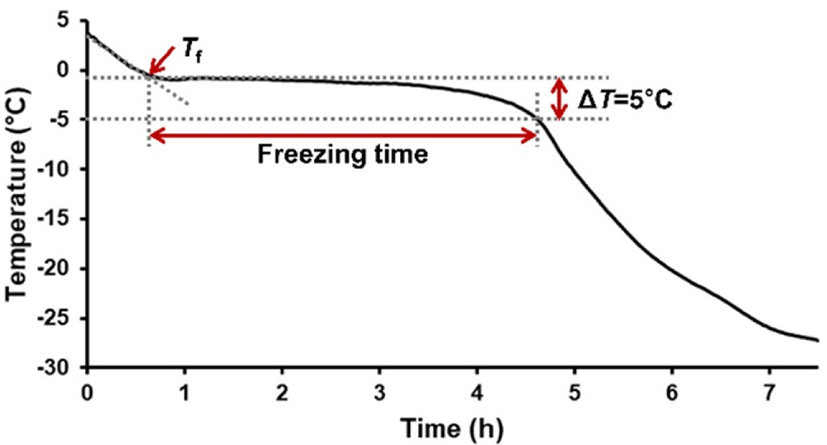
The lyophilized samples were sliced vertically through the muscle fiber using a microtome blade (HFE-A35, Feather® Safety Razor, Osaka, Japan). The microstructure of the samples was observed using a scanning electron microscope (TM4000Plus, Hitachi High-Technologies, Tokyo, Japan) with an acceleration voltage of 20 kV. The ice crystal size was estimated based on the equivalent diameter, as described in Zhu et al. (2003).
The surface color of the thawed pork loins was determined using a color reader (CR-10, Konica Minolta Sensing, Tokyo, Japan) calibrated with a standard white tile. Three positions of each cube were randomly selected, and CIE L*, a*, and b* were taken as indicators of lightness, redness and yellowness, respectively.
After thawing, the packaging film was removed, and the surface exudate of each cube was gently wiped out using a tissue. The cubes were weighed, and thawing loss was calculated by the percentage of weight loss before freezing and after thawing. Meat cubes were placed inside a plastic bag and cooked in a 75°C water bath for 30 min. The cooked meat samples were cooled at ambient temperature for 30 min and then weighed. Cooking loss of pork loin was calculated by the percentage of weight loss before and after cooking.
The cooked cubes were shaped into strips (10×10×15 mm) and sheared using a texture analyzer (CT3, Brookfield Engineering Lab., Stoughton, MA, USA) equipped with a shear blade (TA25/1000, Brookfield Engineering Lab.) under the conditions of 0.5 gf trigger load and 1 mm/s head speed. Four strips from each cube (a total of 24 strips from each treatment) were sampled, and the strip was cut once in the center of the long axis.
A completely randomized block design was adopted to analyze the effects of freezing temperature and air flow rate on the quality characteristics of the pork loins. Data obtained from three repeated experiments were analyzed by two-way analysis of variance (ANOVA) using R software. When the main effects were significant (p<0.05), Duncan’s multiple range test was conducted as a post hoc procedure.
Results and Discussion
In this study, combining air flow rates and freezing temperatures produced broad ranges of freezing rates from 0.26 to 1.42 cm/h (Fig. 2A). Traditionally, slow freezing and quick freezing are classified based on a freezing rate of 0.5 cm/h (Sherrington and Gaman, 2011), and this study included both freezing rate classifications. At a conventional freezing condition (–20°C), 1.5 m/s of air flow rate did not affect the freezing rate of pork loin, and 3 m/s of air flow rate was necessary to achieve quick freezing of pork loin (0.72 cm/h) comparing to natural convective condition (0 m/s). By decreasing the freezing temperature to –30°C, an air flow rate of 1.5 m/s was sufficient to quickly freeze the pork loin (0.63 cm/h), and pork loin freezing was faster with an increased air flow rate (p<0.05). Moreover, quick freezing of pork loin was possible without air flowing at –40°C, although increasing the air flow rate accelerated the freezing rate of pork loin. Based on ANOVA, temperature and the air flow rate showed linear (p<0.001) and interaction effects (p<0.01) on the freezing rate of pork loin (Table 1). The results clearly indicated that the air-blast system effectively accelerated the freezing rate of pork loin and could produce a freezing rate as fast as deep freezing (lower than –40°C) even at relatively higher temperatures (–20°C to –30°C). Since the heat transfer coefficient was affected not only by the air flow rate but also by the freezer temperature, the result satisfied the traditional heat transfer theory (Xanthopoulos et al., 2012). To achieve quick freezing (~0.5 cm/h), however, the effect of the air-blast system was complementary or not required at deep-freezing temperatures (–40°C).
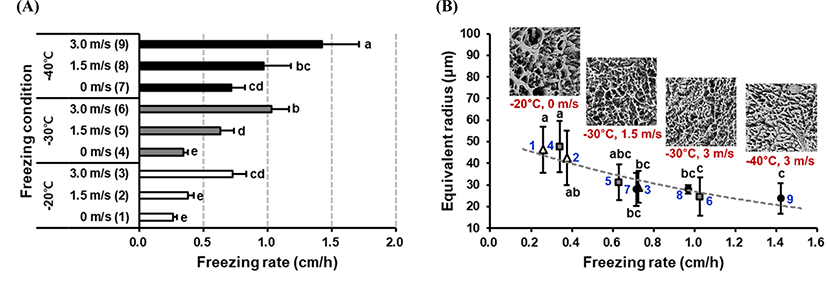
The ice crystal size tended to decrease with increasing freezing rates of pork loin (Fig. 2B). The exponential regression model accounted for 86% of the data fit, as also indicated by Kono et al. (2017). Based on the results, slow freezing (<0.5 cm/h) generated large ice crystals, the equivalent radius of which ranged from 42.5–47.6 μm compared to the 23.8–31.2 μm with rapid freezing treatments (>0.5 cm/h). In particular, the decrease in ice crystal size with freezing rate did not obviously occur in the rapid freezing domain. However, the ice crystal size of pork frozen at 0.63 cm/h (–30°C with 1.5 m/s air flow) did not differ from that with treatment 1 (–20°C without air flow), probably due to a high SD. To generate smaller ice crystals than those produced with treatment 1, a freezing rate greater than 0.7 cm/h was required (p<0.05). However, no difference in ice crystal size was found among the pork loins treated with quick freezing (0.63–1.42 cm/h), reflecting the existence of critical-size ice crystals. According to ANOVA, temperature and the air flow rate significantly affected the ice crystal size (p<0.01), while the variables did not show an interaction effect on ice crystal size (Table 1). Based on ice crystal size, the freezing rate of pork loin could be classified as slow (category I; <0.4 cm/h), intermediate (category II; 0.6–0.7 cm/h) or rapid (category III; >0.96 cm/h). Considering that quality deterioration of frozen meat is caused by the growth of ice crystals, further acceleration of the freezing rate of pork loin from 0.96 cm/h might be disadvantageous from the perspectives of operational cost and energy savings (Nastasijevic et al., 2017).
The thawing loss of pork loin ranged from 1.72%–4.35% and tended to linearly decrease with increasing freezing rates (Fig. 3A). Because the effect of storage period was excluded in this study, the thawing loss of pork was comparably lower than that in ~10% of reports adopting a 6-month storage period (Tomaševi et al., 2015). Therefore, experimental deviations showed little significance for thawing loss among treatments. Nevertheless, compared to that with conventional freezing (treatment 1), significantly low thawing loss was found in category III (p<0.05). Since thawing loss of frozen meat was solely attributed to freezing conditions, the result indicated that meat quality in category II, where meat was treated following the standard of traditional quick freezing (0.5 cm/h), was not better, as is frequently argued (Farouk et al., 2004).
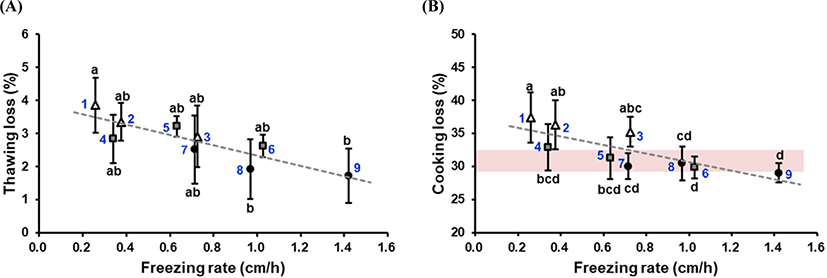
A similar result was also found for the cooking loss of pork loin (Fig. 3B). Compared to fresh control (unfrozen, 31.0±2.11%), pork in category I or II tended to show high cooking loss, and particularly cooking loss of pork in category I was higher than fresh control, whereas cooking loss of pork loin in category III was within the same range of the fresh control meat. Wagner and Añon (2007) observed that myosin denaturation was highly pronounced in slowly frozen meat, which supports the results of this study. In a comparison among freezing treatments, the pattern of cooking loss also showed linearity with the freezing rate. However, the regression model of cooking loss showed less of a relationship with freezing rate (r2=0.62) than that of thawing loss (r2=0.75) because cooking loss of meat was affected not only by freezing conditions but also by cooking conditions (Ježek et al., 2019). However, cooking loss was closely correlated with juiciness, which was an important indicator to predict the chewiness and mouthfeel of meat (Aaslyng et al., 2003). To set a standard for quick freezing, cooking loss was more informative than thawing loss, and rapid freezing would belong to the scope of category III (>0.96 cm/h). ANOVA data indicated that both thawing loss (p<0.001) and cooking loss (p<0.01) were affected only by temperature and not by air flow (Table 1). Decreasing the temperature by 10°C was likely more effective for accelerating the freezing rate, thereby providing a significant change in both drip losses of pork loins, than increasing the air flow rate by 1.5 m/s.
The freezing rate had little or no effect on the color of pork loin after thawing. The L* of pork loin ranged from 48.6–53.2, without a significant difference among treatments (Fig. 4A). The L* values of frozen pork loin were generally within the range of fresh control meat. However, both a* and b* of pork loins showed a significant effect depending on the freezing rate. Category I tended to show lower a* values than categories II and III, and the a* values increased with the freezing rate (Fig. 4B). In particular, category III showed a similar a* value to the fresh control meat. This pattern of a* values was also observed for the b* values of pork loin (Fig. 4C). Because increases in both a* and b* resulted in greater chroma, the results of this study indicated that meat color was ideally red when quick freezing was applied. Since the color parameters of meat provide information regarding the chemical states of myoglobulin and myofibrillar proteins, they serve as an important indicators of meat freshness (Chun et al., 2014; Kim and Hong, 2016). From the results, applying rapid freezing (>1 cm/h) was advantageous for engendering a perception of fresh pork loins, which is consistent with previous reports (Choi et al., 2016; Kim and Hong, 2016). However, whether the color differences observed in this study could be visually detectable was unclear. The ΔE of frozen pork loin ranged from 2.45–5.84 units without significant differences among treatments (Fig. 4D). Although the threshold of color differences was not clearly defined, generally, 2–6 units of ΔE was regarded as a detectable color difference in meat (Tomasevic et al., 2019). Notably, pork loins did not experience long periods of storage in the current study; hence, the observed color parameters did not reflect a clear advantage of quick freezing of pork loin. For ANOVA, freezing temperature was the main contributor to the a* (p<0.001) and b* values (p<0.01), but the air flow rate did not affect the CIE color parameters (Table 1), again confirming that the color parameters were closely related to the total amount of drip generation during thawing and cooking rather than freezing conditions. Nevertheless, the color of quickly frozen pork loins was expected to be more stable since rapid freezing enabled the maintenance of high a* and b* values after freezing and thawing, and the oxidative chemical metabolism affecting meat color was steeply delayed under frozen storage (Choi et al., 2016; Kim and Hong, 2016).
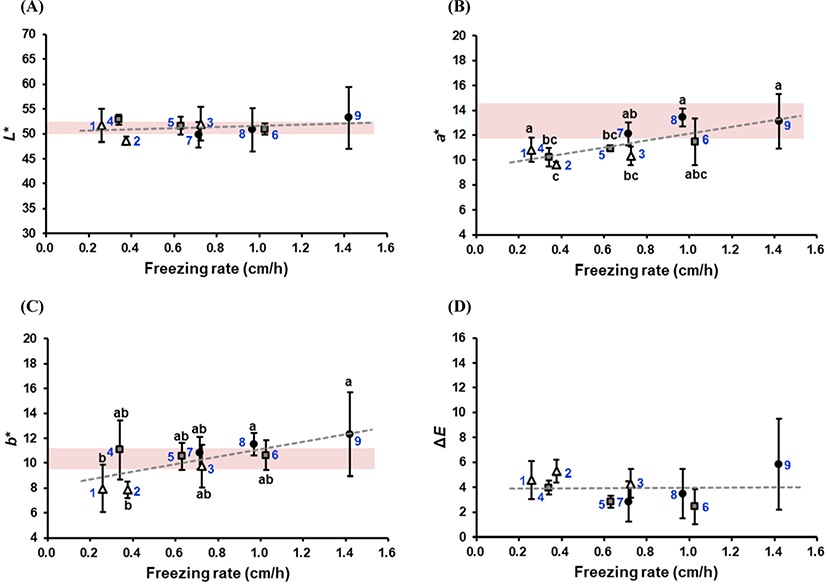
The shear force in frozen pork was clearly distinct based on categories of freezing rates (Fig. 5). Comparing treatment 1, pork within categories II and III exhibited low shear force; however, overall differences in shear forces between the two categories were not found. Moreover, all frozen pork showed lower shear force than fresh pork loin excluding category I meat. Physical damage caused lower shear force values in frozen meat than in unfrozen control meat (Tippala et al., 2021). However, the decrease in shear force with the freezing rate was not explained by physical damage because the damage was believed to be attributed to ice crystal size. As shown in the ANOVA (Table 1), both temperature and the air flow rate affected shear force in the treatment groups, indicating that the shear force of pork loin was related to freezing conditions. Nevertheless, the impact of freezing on the tenderness of meat is not consistent across the literature. Petrović et al. (1993) reported that protein denaturation in slowly frozen meat resulted in less protein solubility and caused a less tender meat structure. Lagerstedt et al. (2008) indicated that frozen meat had lower shear force than unfrozen control meat, but sensorial perception of tenderness was lower due to less juiciness. Based on Cheng et al. (2021), frozen semimembranosus and semitendinosus muscles showed higher shear force than unfrozen muscles, which was related to the characteristics of muscle fibers. Meat tenderness may rely on the aging period prior to freezing, which would produce different results for frozen meat tenderness. The tenderness of frozen meat was compared with sensorial perception to estimate the optimal freezing condition, nonetheless, the results indicated that intermediate or rapid freezing had an advantage of producing tender pork loin compared to slow freezing treatment.
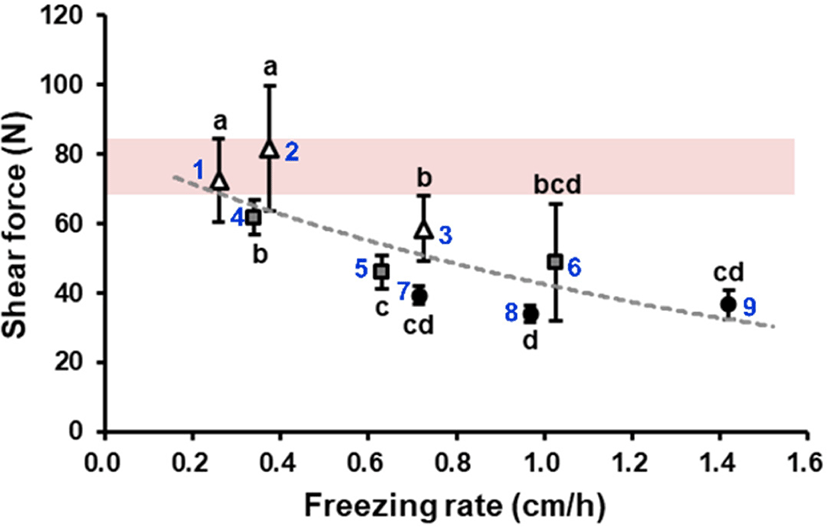
Conclusion
Based on the results, rapid freezing was obviously favorable for maintaining meat qualities as fresh as unfrozen conditions. Rapid freezing effectively minimized drip loss and color and textural changes, and these advantageous results were due to minimal ice crystal formation. Nevertheless, the freezing rate of 0.5 cm/h as a standard for rapid freezing was questionable since the qualities of pork within category II were not different from those within category I, and a freezing rate of at least 0.96 cm/h was required to identify differences in quality parameters compared to those achieve with conventional freezing (–20°C without air flow). As a new standard for rapid freezing, the air-blast system showed a potential advantage, however, the freezing temperature must be lower than –30°C.













